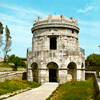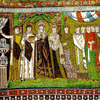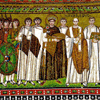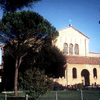|
|
|
Ravenna City Guide Italy
|
 |
 |
 |
 |
| Mausoleum of Theodoric |
San Vitale: Empress Theodora |
San Vitale: Justinian and his retinue |
Sant’Apollinare in Classe |
Directories of Web Sites:
Ravenna City Italy
Ravenna City Hotels
Ravenna City Guide
Ravenna probably dates to the second millenum B.C. It was the base for the roman western mediterranean fleet during the reign of Emperor Augustus (1st century AD) and was made capital of the Western Roman Empire by Honorius in 402 AD. In the 5th and 6th centuries under the Goths (King Theodoric conquered it in 493) and from 540 AD, under the Byzantines, the city was enriched with outstanding monuments and buildings. During the rule of the Da Polenta family Ravenna welcomed Dante Alighieri who died there in 1321. The city was then dominated alternatively by the Venetians and the Holy See until 1859. Its most important buildings include S. Apollinare Nuovo and in Classe, The Mausoleum of Theodoric and the Baptistries. Art treasures from various epoches can be seen in the National and Archiepiscopal Museums, the Classense Library and the Municipal Art Gallery wich contains an impressive collection of 15th and 16th century paintings on wood and canvas, chifly from the Romagna area. The city centre is at its most animated in Piazza del Popolo which is almost like an elengant drawing room with its bars, cafés and shops. RavennaÕs city of art tradition however is specially linked to the great, precious mosaics, still intact today, which made its rich complex of 5th and 6th century Byzantine buildings unique in the world. These religious buildings with their precious mosaics have been declared patrimony of humanity by Unesco World Heritage List. A fascinating historical-artistic heritage, the richest and best preserved testimony of early Christian and byzantine art in Italy.
The tradition of mosaic decoration is still alive today in the studios that reporduce the masterpieces of antiquity and create mosaic versions of contemporary works of art. If you want to learn about current mosaic trends a visit ato the permanent exhibition of contemporary mosaics at the Loggetta Lombardesca is a must.
Ravenna's gres at historical and artistic heritage is coupled with a high level of cultural vivacity. Many top-level theatrical, ballet, opera and concert events take place during the year. The main summer appointement, from June to the end of July, is the international opera and symphony concert event Ravenna Festival, held in the city&Mac185;s most prestigious places such as the Church of S. Vitale and the Basilica of S. Apollinare in Classe. The summer calendar also offers other memorable dates among which, from June to August, &Mac179;Bella di Sera&Mac178; with more than 50 events held in the most evocative venues of the old town, the Jazz Festival in July at the beautiful Rocca Brancaleone and the August Organ Music Festival in the Church of S. Vitale. On Friday evenings all the shops in the city centre stay open and the S. Vitale complex is open to visitors. If you come to Ravenna you&Mac185;ll fall in love with it, as happened in the past to Boccaccio, who set one of his finest stories here, to Gustav Klimt who was clearly inspired by the city, to Hermann Hesse who wrote a poem about it. Ravenna responded by donating a mosaic of one of his watercolours to the museum in Lugano which was one Hesseıs home.
The local cuisine is famous for its rich variety of carefully prepared typical products. Delicious homemade pasta for example. Tagliatelle and lasagna with the classic meat sauce; the exquisitely refined ³cappelletti² with cheese filling, cooked in capon broth. People from the Ravenna area have made a fine art of barbecuing meat and the various types of fish that the sea supplies in abundance. These are often served with the traditional ³piadina². Desserts include Romagnol ciambella and ³zuppa inglese², a kind of trifle made with custard and cordial-soaked biscuits, Internationally famous quality wines such as Sangiovese, Albana and Trebbiano complete the gastronomic picture for the gourmet visitorıs pleasure.
To the west of Ravenna is located the city of Faenza. It dates back to Etruscan - Roman times. It has been reknowned for its ceramic production since the 12th century and today has to more than 60 ceramic workshops. There are two recommended tourist itineraries - firstly a Renaissance itinerary, including the Cathedral and the central squares, and secondly a Neo-classical itinerary, including the Milzetti Palace and Masini Theatre. In addition, the city boasts the famous International Ceramic Museum which features collections from different countries and periods and also hosts a range of international artistic and handicraft events.
(Part of the Contents are taken from "Ravenna – Ravenna intorno – Verde, Azzurro, Oro" gently given by Comune di Ravenna – Tourist Board) |
|
|
|
Acquista la tua visibilità su Travel Plan
|
|
|
|